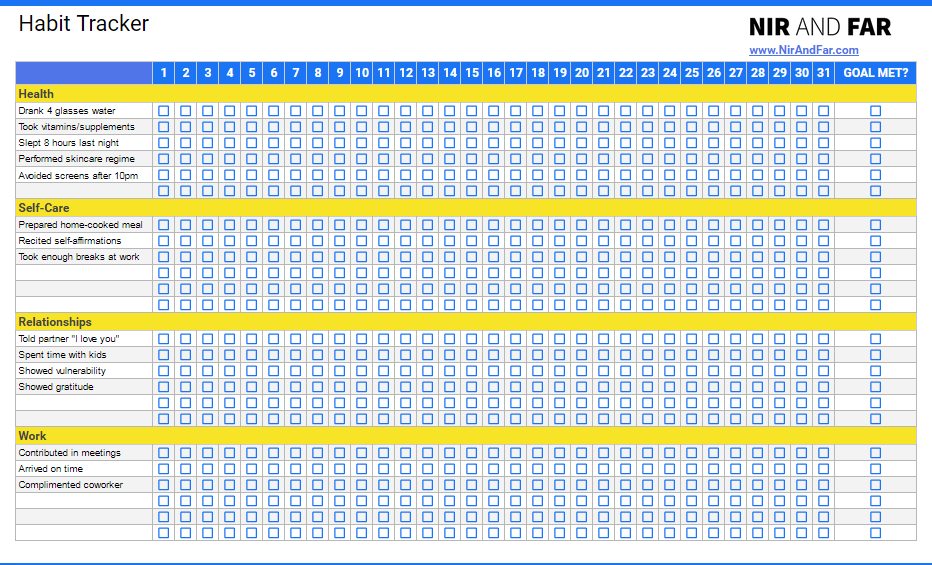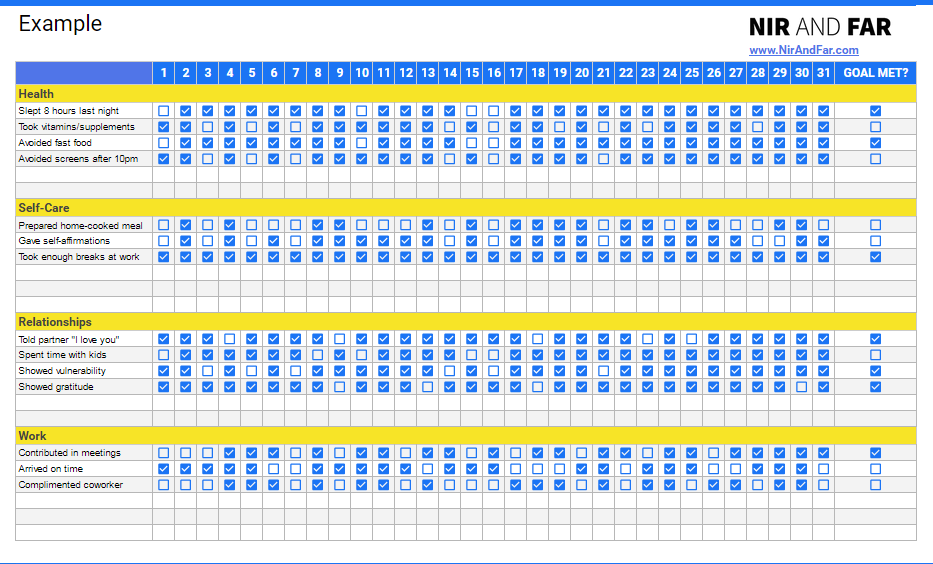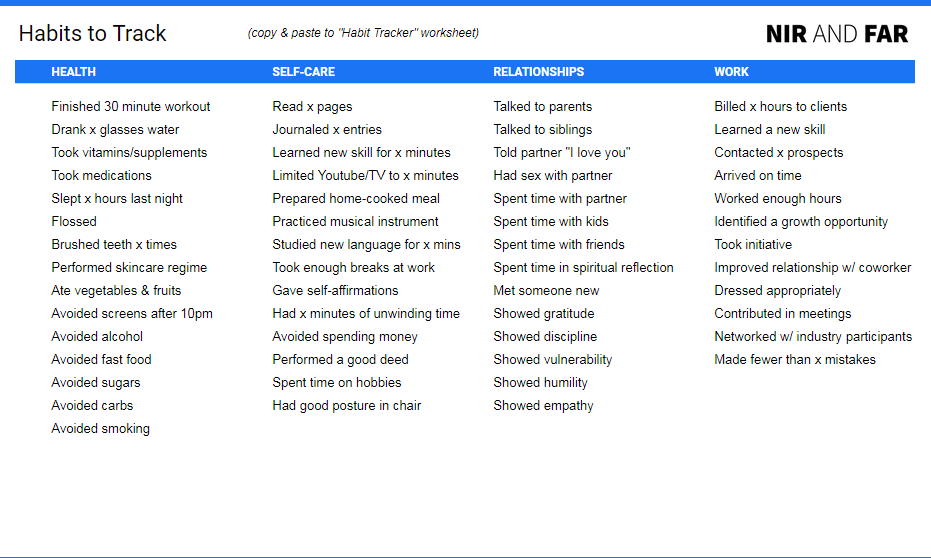Habit Trackers: How They Work and How to Use the Template
By Annie Graham
Many people strive to improve themselves in one way or another. Whether it’s getting more sleep and exercise, or spending more time doing the things we love, our ideal selves drive us to be better. They symbolize our belief in our own potential to live in alignment with our values.
The drive to improve is also why strategies and tools that enable us to track our behaviors are so potentially gratifying. It feels good to see ourselves moving closer to our goals.
One of these tools is the habit tracker—used to record our behaviors and visualize a trajectory toward better versions of ourselves.
Renowned entrepreneur Jim Rohn spoke to the power of habit when he said, “Success is nothing more than a few simple disciplines, practiced every day; while failure is simply a few errors in judgment, repeated every day.”
Indeed, the small things we do on a day-to-day basis make up who we are. And habit trackers are a great lever to change them.
That is, if they work.
Oftentimes, habit trackers don’t work if they are designed or used improperly. It’s important to understand how to properly set up a habit tracker template so we can make the most of a potentially effective behavior change tool.
What is a habit tracker?
A habit tracker can be as simple as pen and paper—e.g., printable grids and customizable habit-tracking journals—or digital templates, such as our free Google Sheets template, which works both online and printed on paper.
If you want to go a step further, habit-tracking apps provide easy, fun ways to log habits on the go:
How do habit trackers work?
Habit trackers work by increasing motivation and accountability—in many ways, their strategies leverage parts of the Nir Eyal’s Hooked Model.
Digital habit trackers can send scheduled push notifications and reminders that serve as the cue to perform an action. That’s why they are particularly helpful for habits that require external triggers: They remind us to do the action at the right time.
Proper timing makes the action part of the Hooked Model easier. For example, you’re much more likely to make your bed in the morning, when you’re at home, than at 2pm when you’re out of the house. Making the action easier also increases the chance that people will stay in the loop.
After we complete an action, we mark it as “complete” in our tracker, which not only increases the reward we feel but also enables us to picture our progress.
Habit trackers also capitalize on a powerful part of the Hooked Model: investment. Investment refers to the process of the service improving every time a person uses it. It keeps users engaged in a service because they have unlocked a better experience and have something to lose if they stop visiting.
Habit-tracking apps in particular take advantage of investment by using gamification: Users return to the app and continue their routine because they don’t want to lose their streak, badge, or other investment.
Habit trackers also help us focus on the behaviors we want to work on. By putting them down on paper or typing them into an app and having that list handy, we externalize our goals and increase accountability. Some tracking apps have social features that allow you to share your goals and progress with friends, which adds variable rewards, ups the ante, and theoretically keeps you motivated.
Free Habit Tracker
Design your ideal day and build your best life.
Your email address is safe. I don't do the spam thing. Unsubscribe anytime. Privacy Policy.
Why habit trackers sometimes don’t work
Many of the “habits” that people try to build using trackers are not habits at all. A habit doesn’t require conscious thought or deliberate practice—it happens automatically when cued by a trigger, like turning the lights off when you leave a room.
Yet people often track actions, like meditation, that require both conscious thought and deliberate practice. These actions should be labeled “routines” rather than “habits.”
This distinction is helpful in explaining why habit trackers sometimes don’t work.
Often, people pick something too ill-defined or hard to measure and expect to automate behaviors that simply aren’t automatable. These unrealistic expectations can push people to fall off the wagon when the behavior never becomes easy and can lead to feelings of disappointment and shame that deter them from achieving their desired behaviors.
How to use this Google sheet template
When you choose the habits you’d like to add to the Google sheet, be mindful of which behaviors can become automatic habits and which are more deliberate—you don’t have to exclusively include the former, but it’s a good distinction to note upfront.
To decide what to track, break down the domains of your life and brainstorm a list of behaviors you’d like to regularly incorporate into each domain:
- Health (drinking water, working out, taking medications, flossing)
- Self-care (meditating, reading, journaling, learning a new skill)
- Relationships (talking to family members, spending time with kids)
- Work (arriving on time, upskilling)
For inspiration, you can find a list of 50+ ideas on the “Lists of Habits” tab of our habit tracker template.
Next, input the behaviors into the template and schedule them in your day. This is critical when you are first adopting a new habit. Use timeboxing to specify when you will do the action specified in your habit tracker. If the task isn’t scheduled, odds are, you won’t remember to do it. Above all, avoid judging yourself too harshly as you track your habits—progress isn’t linear, and some behaviors are genuinely difficult to build. It’s important to have a plan in place for what you will do when you fall off track.
You can also further manipulate the reward and investment in your hook. For example, you can promise yourself a reward if you complete a certain amount of days in a month. The best kinds of rewards are the ones that encourage more of the behavior you’re trying to routinize instead of sabotaging it. So instead of rewarding yourself with a trip to an all-you-can-eat buffet if you hit an exercise or weight loss goal, consider rewarding yourself with a new piece of fitness equipment or clothing.
Best of all, focus on the joy of doing the task itself. Research on the overjustification effect has shown that extrinsic rewards can decrease our intrinsic motivation to do something. In other words, if we complete a task for a monetary reward or even for the joy of checking a box on a habit tracker, for example, we feel a decreased motivation to do it for its inherent benefits, such as the satisfaction or joy it provides.
The ultimate goal of a habit tracker is to no longer need to use it. If it’s effective, you’ll want to do the behavior on your own.
Habit Tracker Ideas
HEALTH
- Finished 30 minute workout
- Drank x glasses water
- Took vitamins/supplements
- Took medications
- Slept x hours last night
- Flossed
- Brushed teeth x times
- Performed skincare regime
- Ate vegetables & fruits
- Avoided screens after 10pm
- Avoided alcohol
- Avoided fast food
- Avoided sugars
- Avoided carbs
- Avoided smoking
SELF-CARE
- Read x pages
- Journaled x entries
- Learned new skill for x minutes
- Limited Youtube/TV to x minutes
- Prepared home-cooked meal
- Practiced musical instrument
- Studied new language for x minutes
- Took enough breaks at work
- Gave self-affirmations
- Onserved x minutes of unwinding time
- Avoided spending money
- Performed a good deed
- Spent time on hobbies
- Had good posture in chair
RELATIONSHIPS
- Talked to parents
- Talked to siblings
- Told partner “I love you”
- Had sex with partner
- Spent time with partner
- Spent time with kids
- Spent time with friends
- Spent time in spiritual reflection
- Met someone new
- Showed gratitude
- Showed discipline
- Showed vulnerability
- Showed humility
- Showed empathy
WORK
- Billed x hours to clients
- Learned a new skill
- Contacted x prospects
- Arrived on time
- Worked enough hours
- Identified a growth opportunity
- Took initiative
- Improved relationship w/ coworker
- Dressed appropriately
- Contributed in meetings
- Networked w/ industry participants
- Made fewer than x mistakes
Try Our Google Sheets Habit Tracker Template
Now that you have a sense of what habit trackers are, how they work, and what to watch out for, you can experiment with them and get a sense of how they work for you. The advantage of the Google Sheets format is that you can customize it to your needs.
Everyone has different ideas of what the ideal self is, and we all respond differently to external rewards and motivations. The journey toward your ideal self is ongoing, so you might as well go forward with self-compassion and curiosity to enjoy it along the way.
Annie Graham is a former software engineer and current doctoral student in clinical psychology.
Free Habit Tracker
Design your ideal day and build your best life.
Your email address is safe. I don't do the spam thing. Unsubscribe anytime. Privacy Policy.
Related Articles
- Schedule Maker: a Google Sheet to Plan Your Week
- Habit Tracker Template in Google Sheets
- The Ultimate Core Values List: Your Guide to Personal Growth
- Timeboxing: Why It Works and How to Get Started in 2024
- An Illustrated Guide to the 4 Types of Liars
- Hyperbolic Discounting: Why You Make Terrible Life Choices
- Happiness Hack: This One Ritual Made Me Much Happier



